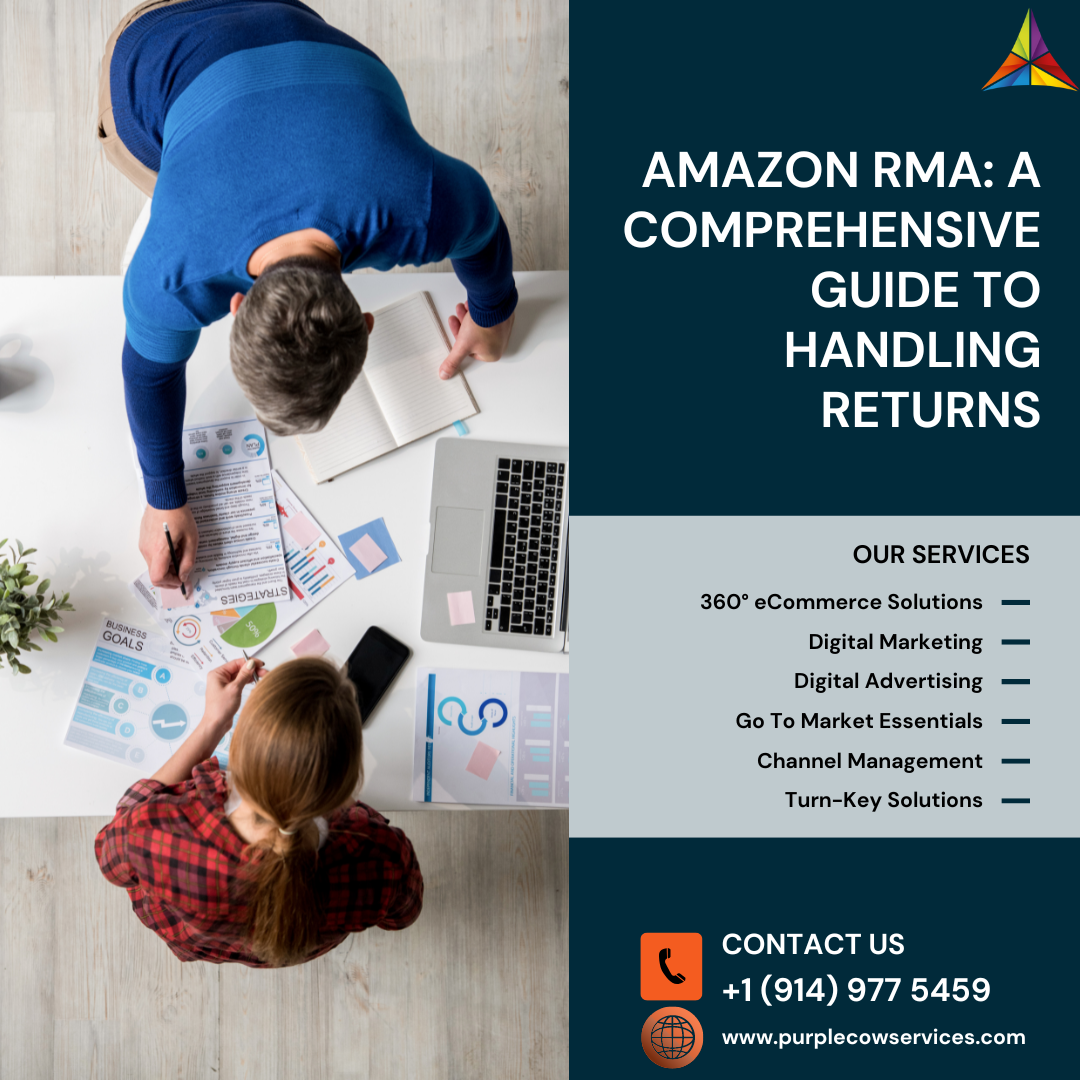When embarking on your Amazon selling journey, it's easy to get caught up in the excitement of launching products and attracting customers.
Share This Story, Choose Your Platform!
However, one aspect that many sellers tend to overlook, especially in the early stages, is return logistics. Returns are an inevitable part of eCommerce, and how you handle them can significantly impact your business. In this comprehensive guide, we’ll delve deep into the world of Amazon Return Merchandise Authorization (RMA), demystifying the complexities of the return process. Whether you’re a seasoned seller or just starting, understanding Amazon RMA is essential for providing excellent customer service and managing your eCommerce business effectively.
What Does RMA Stand For?
To begin our journey into the realm of Amazon RMA, let’s start with the basics. RMA stands for Return Merchandise Authorization, which serves as a designated ID number used by Amazon and other eCommerce platforms to track return requests. This ID number is a vital component in streamlining the return process, benefiting both buyers and sellers.
At its core, RMA simplifies the intricate dance of returns. It allows for the structured handling of returns for various purposes, including replacements, repairs, or refunds. Let’s explore further how this system works and why it’s so crucial.
The Role of the RMA Number on Amazon
The RMA number is not just a random sequence of characters; it’s the linchpin of the return process on Amazon. It serves as a tracker, helping buyers and sellers monitor the progress of returns with precision and accuracy.
Sellers leverage the RMA number to keep tabs on return quantities and the reasons behind returns. This information is invaluable for managing inventory and understanding customer preferences and pain points. On the other side of the spectrum, Amazon utilizes the RMA number to manage returned products within its vast warehouses, ensuring they don’t get mixed up with new inventory.
Moreover, the RMA number provides critical insights for sellers. For example, if multiple returns of the same product occur, it might signal an issue with the product itself or inaccuracies in the product listing on Amazon, such as unclear images or insufficient information.
In essence, the Amazon RMA system acts as a cohesive force that helps both buyers and sellers navigate the intricate web of returns efficiently.
Where Do I Find the Amazon RMA Number?
Now that we understand the importance of the RMA number, you might be wondering where to find it. Well, the good news is that Amazon takes care of this for you.
When a customer initiates a return request that falls within Amazon’s return policy, the eCommerce giant automatically authorizes the return request and generates a return authorization slip. Within this slip lies the coveted RMA number, neatly printed below the return label.
However, in cases where the return request doesn’t align with Amazon’s return policy, sellers can step in and manually review the request. This review process empowers sellers to make the call and generate the RMA number themselves. Regardless of how it’s obtained, this unique identifier is the key to unlocking the return process’s efficiency.
How RMA Benefits Both Sellers and Customers
At first glance, RMA might seem like just another administrative step in the eCommerce process. However, it’s much more than that. It’s a mechanism that offers substantial benefits to both sellers and customers, creating a win-win situation for all parties involved.
The advantages that Amazon RMA brings to the table:
Streamlined Returns Process: One of the most apparent benefits of RMA is the streamlining of the return process. By providing a structured framework for handling returns, it allows sellers to categorize and track return requests efficiently. This reduction in administrative complexity saves time and resources.
RMA simplifies the return process for customers as well. It provides clarity and ease of use, making it straightforward for buyers to initiate and track their returns. This transparency can significantly enhance the overall customer experience.
Improved Customer Experience: In the competitive world of eCommerce, providing an exceptional customer experience is paramount. Amazon RMA enables you to do just that. By offering a transparent and well-organized return process, you can build trust with customers.
This trust can translate into repeat purchases and positive reviews, both of which are invaluable for the long-term success of your Amazon business. An easy, hassle-free return process can turn a potentially negative experience into a positive one, fostering loyalty among your customers.
Accurate Inventory Management: For sellers, maintaining accurate inventory counts is essential. The unique RMA numbers provided by Amazon’s system enable sellers to distinguish between returns and regular orders with ease. This differentiation prevents confusion and ensures precise inventory counts.
Furthermore, accurate inventory management reduces the likelihood of customers receiving damaged or incorrect products, which can significantly impact customer satisfaction.
Data-Driven Insights: In the world of eCommerce, data is king. Amazon RMA provides sellers with a wealth of data regarding return trends and reasons. By analyzing this data, sellers can identify potential issues with their products or product listings.
For instance, if a particular product consistently garners return requests with the same reason (e.g., “too big” for a t-shirt), this data can serve as a valuable indicator for product improvement. It allows sellers to address specific pain points and enhance product quality.
Efficient Refund and Reimbursement: In the world of eCommerce, speed is of the essence. Customers appreciate prompt resolutions, and RMA facilitates precisely that. It speeds up the refund process, allowing customers to receive their money back or a replacement product sooner.
This efficiency reinforces customer trust and loyalty, as customers feel that their concerns are promptly addressed and resolved.
RMA vs. RA vs. RGA – Understanding the Differences
In the realm of returns, several terms often seem interchangeable, causing confusion among sellers. RMA, RA, and RGA are three such terms that are frequently used interchangeably, but they are not quite the same.
Let’s take a moment to understand the differences between these terms:
Amazon RMA (Return Merchandise Authorization): RMA, as we’ve discussed, is a standardized return process primarily used for eCommerce platforms like Amazon. It provides a structured framework for handling returns.
RA (Return Authorization): Return Authorization, or RA, allows customers to return products. However, unlike RMA, RA is not as standardized and can vary between industries and marketplaces. The implementation of RA can differ significantly based on the specific business context.
RGA (Return Goods Authorization): Return Goods Authorization, or RGA, is primarily used for returning defective or damaged goods directly to manufacturers. It serves as a means for manufacturers to authorize and process returns efficiently.
Understanding these distinctions is crucial, as it ensures that you use the correct terminology and approach when dealing with return processes.
How Does RMA Work With Amazon’s Return Policy?
Amazon has two primary fulfillment processes: FBA (Fulfillment by Amazon) and FBM (Fulfillment by Merchant). These processes come with their own set of rules and procedures when it comes to Amazon RMA.
Let’s explore how RMA works differently with each fulfillment process:
Amazon FBA: If you’re an Amazon FBA seller, the Amazon RMA function comes into play once a customer requests a return. Here’s a step-by-step breakdown of how it works:
Return Request Initiation: When a customer initiates a return request for a product purchased from an FBA seller, Amazon’s automated system processes the request.
Amazon’s Evaluation: Amazon’s system assesses the return request to determine if it aligns with the return policy. If the request falls within the Amazon return window, Amazon approves the return request.
RMA Number Generation: Once the return request is approved, Amazon assigns a unique RMA number to the transaction. This RMA number serves as a reference point for tracking the return throughout the process.
Prepaid Return Label: Amazon generates a prepaid return label for the customer, allowing them to ship the item back to the FBA fulfillment center at no cost. The RMA number is included on the return label for easy identification.
Item Reception and Inspection: Upon receiving the returned item at the FBA fulfillment center, Amazon’s staff inspects the product. If the item is in sellable condition, it is returned to the inventory for future orders. Amazon then refunds a portion of the referral fee and the variable closing fees associated with the product.
If the product is unsellable due to issues caused by Amazon, it is not added to inventory. In this case, Amazon refunds the selling price along with a portion of the referral fee and taxes.
If the defect is attributed to the seller, the product is not added to inventory, and Amazon refunds the full referral fee along with the variable closing fees.
Additionally, FBA sellers can closely monitor their returns through the Seller Central account, gaining insights into reasons for returns and tracking reimbursements. This data provides valuable information for understanding return trends and product quality.
Amazon FBM: For Amazon FBM sellers, the process of handling Amazon RMA differs slightly:
Return Request Initiation: When a customer initiates a return request for a product purchased from an FBM seller, Amazon handles the request in two ways:
Automated Authorization: If the return request falls within Amazon’s 30-day return policy, Amazon automatically authorizes the return request.
Manual Authorization: If the return request doesn’t fall within any Amazon policy, sellers have the flexibility to authorize the return requests manually.
Processing Return Requests: FBM sellers can log in to their Seller Central account and navigate to the “Manage Returns” section from the left sidebar to process return requests. In the “Pending Actions” tab, sellers can view all pending requests.
For each return request, sellers have four action buttons: “Authorize,” “Deny request,” “Issue refund,” and “Contact Buyer.”
Upon authorizing a return request, Amazon offers two options: sellers can use a pre-generated RMA number from Amazon, or they can create their custom RMA number for the return. Buyers also receive a copy of the RMA number within a return authorization slip, which they can print and attach to the product being returned.
Best Practices for Managing Amazon Returns
Returns are an inherent part of the eCommerce landscape, and as an Amazon seller, you’ll encounter them sooner or later. Customers may change their minds, receive damaged products, or simply not like what they ordered. While returns can be frustrating and costly, they are also an opportunity to provide excellent customer service and build trust with your buyers.
Here are some best practices for managing Amazon returns effectively and minimizing their impact on your business:
Contact Customer Within 24 Hours
When a customer initiates a return request, make it a priority to respond within 24 hours. Provide the necessary information and, most importantly, thank them for their purchase. Apologize for any inconvenience caused by the return.
This proactive approach demonstrates your commitment to customer satisfaction and the value you place on their feedback. Additionally, keep a close eye on the return’s status and issue a refund promptly upon receiving the returned item. If any delays or issues arise during the return process, keep the customer informed and offer a solution.
Use Amazon’s Prepaid Return Labels
Handling returns can be a time-consuming and potentially costly process. One of the simplest and most efficient ways to manage returns is by utilizing Amazon’s prepaid return labels. With this solution, you can generate a return label, and Amazon takes care of the logistics, including the receipt, inspection, and processing of the returned item.
This approach not only saves you time and hassle but also reduces the risk of negative feedback or claims from customers. It’s a win-win situation that streamlines the return process for both sellers and buyers.
Analyze Return Data and Identify Areas For Improvement
Returns provide valuable insights into your products, customers, and overall business performance. Make it a habit to regularly review your return data and look for patterns, trends, and root causes of returns.
For instance, you may discover that certain products have higher return rates than others or that customers consistently express dissatisfaction with specific aspects of your products, such as quality, size, or color. This information is a goldmine for improving your product descriptions, images, packaging, quality control, inventory management, and customer service.
Turn Returns Into Opportunities for Repeat Business
Returns don’t have to be a negative aspect of your business. In fact, when handled well, they can become opportunities for creating loyal customers and advocates. Consider offering incentives for future purchases to customers who initiate returns.
These incentives could take the form of discounts, coupons, free shipping, or loyalty points. Additionally, ask satisfied customers to leave positive reviews or ratings. When customers see that you’re committed to resolving issues promptly and providing excellent customer service, they’re more likely to become loyal patrons of your business.
By following these best practices, you can turn a potentially challenging aspect of eCommerce into a chance to build stronger customer relationships and foster repeat business.
Conclusion
In the ever-evolving world of eCommerce, understanding Amazon RMA and mastering the intricacies of the return process is crucial for long-term success as an Amazon seller. Returns are not obstacles but opportunities to demonstrate your commitment to customer satisfaction and build trust with your buyers.
So, embrace the world of Amazon RMA, turn challenges into opportunities, and embark on your eCommerce journey with the knowledge that success is not a destination but a path of continual improvement and growth.
Elevate your Amazon business with Purple Cow’s expertise in Amazon RMA. Our comprehensive guide empowers you to streamline returns, delight customers, and boost profitability. We help you turn challenges into opportunities, ensuring your eCommerce journey is marked by success and growth. Partner with Purple Cow Services and master the art of handling returns with confidence. Stand out in the herd of Amazon sellers today!

















